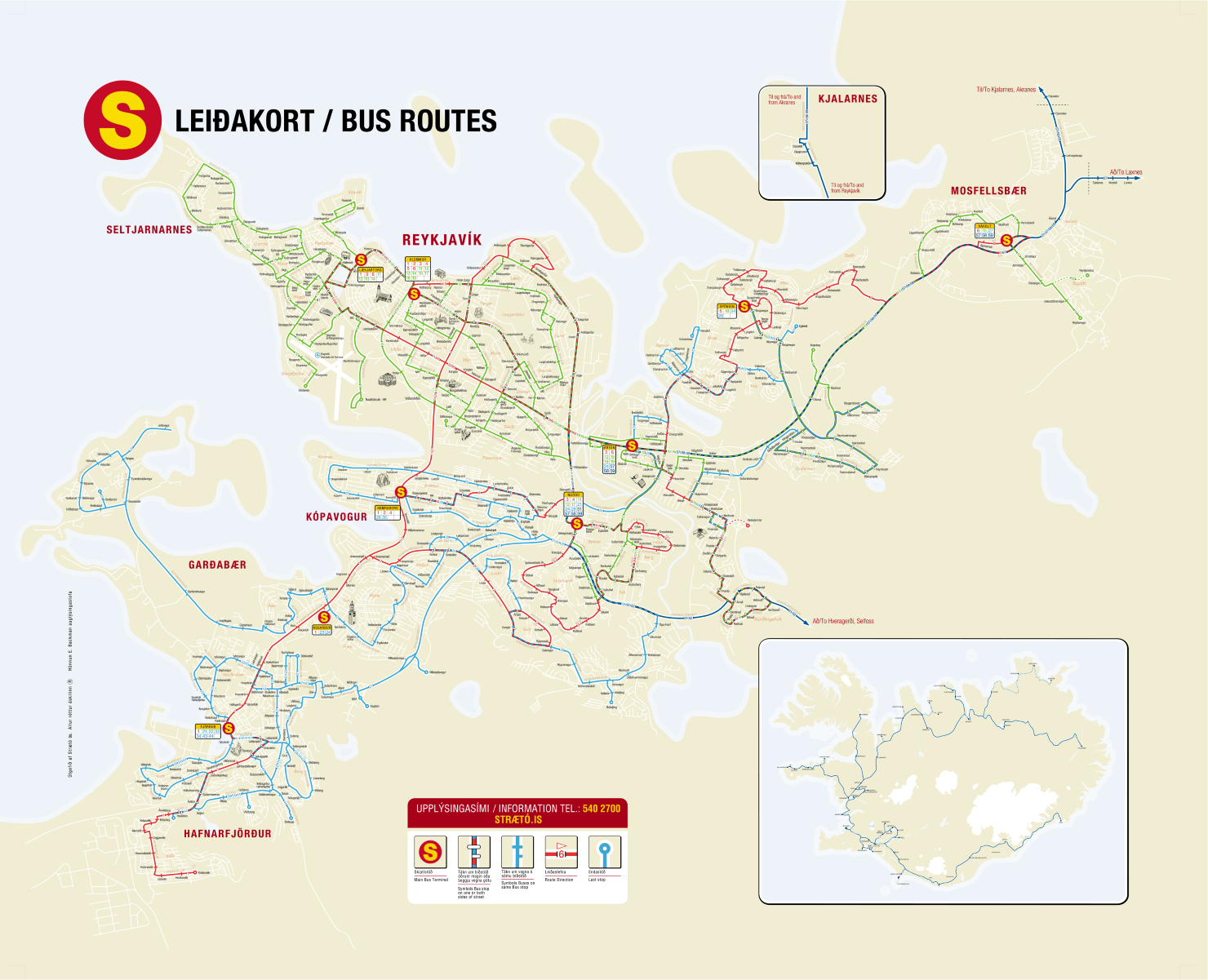Not sure how to use public transportation in Reykjavik? It’s easy on foot when the weather allows, but during the colder months in Iceland it doesn’t feel entirely inviting, or when pulling luggage or carrying packages.
The main form of transportation in Reykjavík is the bus, or Strætó as the locals call it. There is no metro, train or ferry service in Reykjavik. Luckily, the bus service is both accessible and affordable. The most extensive bus services are available within the capital city, Reykjavík, providing comprehensive coverage and frequent schedules.
Need help getting around Reykjavik? Here’s everything you need to know about public transport in the Icelandic capital:
 |
 |
|
|
Buses in Reykjavik
Strætó
Strætó (or Straeto for simplified spelling) is the Reykjavik bus system and offers an extensive coverage of the city, with every corner and neighborhood of Reykjavik on its route, running seven days a week.
The regular buses run between approximately 6:30 am and midnight, with night buses running a few times throughout the wee hours of the morning. For exact times, see the bus route timetables.

How much does a Strætó bust ticket cost in Rejkjavik?
Strætó tickets cost 570 ISK (USD $4.20 / 3.80 EUR) per ride for an adult.
The exact fare is determined by the number of zones crossed during the journey. It is recommended to use a rechargeable bus card (called “strætisgjaldskort”) for frequent travelers, which offers discounted fares compared to purchasing individual tickets.
How to buy a Strætó Bus ticket in Reykjavik?
We highly recommend downloading the Strætó app before you hop on that brighter-than-the-sun yellow bus. The website is convenient as well, and includes a journey planner and timetime. The app also includes a payment method using Visa or Mastercard, so you can forgo worrying about having 570 ISK cash in your pocket.
|
|
 |
 |
 |
Reykjavik bus zones and routes
There are no zones for taking buses in Reykjavik; there’s just one standard fare.
Strætó’s network consists of 27 routes in Reykjavik and 21 additional routes throughout the country. You can plan and map your trip by simply putting in a start and end point on the Strætó website.
All information is easily found on either the website or app, including timetables and a real time map showing where your anticipated bus is currently located. The app covers both city buses and regional buses.

|
|
Straeto bus stops are very easy to spot. Look out for the unmistakable Straeto BS logo, a vibrant red and yellow S. You’ll come across various types of stops, from a logo-topped pole with attached timetables to those featuring cozy shelters where you can wait comfortably for your bus.
Expert tip |
|
Journeys are strategically planned by the transport authority, so that waiting times aren’t long for travellers. Look out for transfer stops like Fjordur, Asgardur, Hamraborg, Mjodd, and Artun, that are easy for commuters to switch between routes hassle-free. Other connection spots include Hlemmur, Spongin, and Haholt, but do note that waiting times there might be slightly longer, as their timetables aren’t specifically designed to optimize transfers.
If you’re travelling between the Reykjavik city buses and regional buses that head outside the capital region, Mjodd in Reykjavik’s Breidholt neighborhood is the go-to stop. It serves as the key connection point for seamless transitions.
Reykjavik bus frequency
In the Reykjavik capital area, buses generally operate at a 15-minute frequency during peak hours and a 30-minute frequency outside of peak hours. Routes 1 and 6 have a 10-minute frequency during peak hours. Buses typically start running at around 06:30 on weekdays, 07:30 on Saturdays, and 09:30 on Sundays.
Half of the bus routes run every day until midnight. On official holidays, buses usually follow a Sunday schedule unless stated otherwise.
Strætó app
You can purchase both bus cards and single rides on the app. It’s preferred to activate your ticket on the app before entering the bus. Activation lasts for 75 minutes. When traveling outside the capital via Strætó, purchase a country ticket.
Download the Strætó app here.
FAQS
Are bikes allowed on the bus?
Bikes are permitted on the bus, if room allows. There’s a designated area for bicycles, baby carriages, and wheelchairs in the center of the bus. Baby carriages and wheelchairs have priority access and therefore bikers can expect to kindly give up their space and wait for the next bus.
Are pets allowed on the bus?
Strætó welcomes pets, but all furry friends must enter through the back door of the bus and stay in the back during the ride. Pets are not allowed during peak hours (between 7 – 9 am and 3 – 6 pm) due to passengers with allergies. Dogs must be on a tight leash or in a secure bag or carrier.
Is there a metro in Reykjavik?
There is currently no metro in Reykjavik.
Is there a train or railway system in Iceland or Reykjavik?
There is currently no railway system in Reykjavik. A light railway system has been proposed and the municipality is now exploring this option.
What are the other forms of public transportation in Reykjavik?
Strætó is the main form of public transportation in Reykjavik. There are also taxis available, as well as private coach lines in vario
Other Useful Information: Wifi, Schedules, and Discounts
- Bus schedules tend to be minimized on holidays
- There’s free WIFI on the buses in Reykjavik
- Double check your scheduled route when traveling at night and weekends
- There’s a Strætó route from Keflavik International Airport to Reykjavik
- There’s no fee for children under 6 yrs old
- There are discounted bust tickets for children 6 – 17 years old, disabled, and elderly people (over 67 yrs old).
Transportation in Iceland
Public transport in Iceland offers convenient and efficient options for both locals and travelers to explore the country’s unique landscapes and vibrant cities.
The backbone of the public transport system in Iceland is the bus network, connecting major towns, smaller communities, and popular tourist destinations. For longer distances, intercity bus services connect different regions of Iceland, offering comfortable and reliable transportation. Additionally, domestic flights are available to reach more remote areas.
The buses in Iceland are known for their punctuality, cleanliness, and friendly service. Whether you’re venturing to the stunning natural wonders like the Golden Circle or exploring the charming towns toward the Westfjords, public transport in Iceland is a convenient and eco-friendly option to navigate the country’s diverse landscapes.
Organised bus tours
There are many private bus companies that provide planned sightseeing tours, bundled and single-day trips, and outings departing from Reykjavík to numerous locations throughout the country.
Some of the popular destinations for sightseeing tours include the Golden Circle, which includes the famous Geysir geothermal area, Gullfoss waterfall, and Thingvellir National Park. Other tours may take visitors to the stunning South Coast, where they can see iconic landmarks like Seljalandsfoss and Skógafoss waterfalls, the black sand beaches of Reynisfjara, and the charming village of Vík.
For those interested in exploring Iceland’s natural wonders further, there are bus trips available to the Icelandic highlands and places like Landmannalaugar, where travelers can soak in natural hot springs and admire the colorful rhyolite mountains. The Snæfellsnes Peninsula is also a popular destination, often referred to as “Iceland in miniature” due to its diverse landscapes featuring volcanic peaks, lava fields, and picturesque fishing villages.
Besides these bundled tours, there are also single-day trips offered to various attractions near Reykjavík, such as the Blue Lagoon, Reykjanes Peninsula, or even to witness the majestic Northern Lights during winter.
These private bus companies often provide informative guides on board who offer insights into Icelandic history, geology, and folklore. They ensure comfortable and safe transportation, making these sightseeing tours a convenient and hassle-free way to explore Iceland’s natural wonders.
Public transport and buses to the Blue Lagoon
In Iceland, the Blue Lagoon is a popular geothermal spa located approximately 23 kilometers (14 miles) southwest of Keflavík International Airport and about 39 kilometers (24 miles) from Reykjavík.
The quickest and easiest way to reach the Blue Lagoon in Iceland is by booking a transfer or taking a public bus from Reykjavik, the capital of Iceland. Many tour companies offer transfers to the Blue Lagoon. These are usually in comfortable minibuses or coaches, and they drop you right at the entrance of the Blue Lagoon.
How long does it take to reach Blue Lagoon from Reykjavik/Keflavik by bus?
The bus transfer time from either location to the Blue Lagoon is typically around 45 minutes to 1 hour, depending on traffic conditions and the specific bus service you choose.
|
|
Remember, due to its popularity, it’s recommended to book your visit to the Blue Lagoon in advance, this includes your ticket to entry and your transportation.
Bus transfers to the Highlands in Iceland
Bus transfers to the highlands in Iceland offer adventurers a convenient and scenic way to explore this breathtaking region. Known for its rugged landscapes, vast glaciers, and remote wilderness, the Icelandic highlands are a dream destination for nature enthusiasts.
Bus transfers provide access to some of the most iconic highland destinations, such as Landmannalaugar and Thórsmörk. These transfers typically depart from major towns like Reykjavík or Húsavík, offering comfortable and reliable transportation options. Depending on the specific route and weather conditions, bus transfers to the highlands can range from a few hours to a full day.
Book a Highlands Busspass Day Tour here
Airport Transfer in Iceland from Keflavik Airport to Reykjavik City With Hotel Drop Off
Many tourists visiting Iceland are surprised by how far away the international airport is from Reykjavik city center. However, an efficient airport shuttle service quickly overcomes this challenge. By booking your shuttle ahead of your journey, you’re guaranteed to have a bus ready for your use immediately upon touchdown. Conveniently, you’ll be dropped off right at your hotel or the closest bus stop.
|
|
Hlemmur terminal fun fact
The former main Strætó terminal, Hlemmur, has been repurposed as a gourmet food hall with a variety of market-driven vendors. It’s an entirely different world than the depressing vibe Hlemmur had for decades prior to the welcomed transformation in 2017! Go get a bite or a drink.

Heads up! This post contains affiliate links. Don’t worry, the commission we make comes at no additional cost to you. For more information on our affiliate program, please see our Disclosure Policy.

